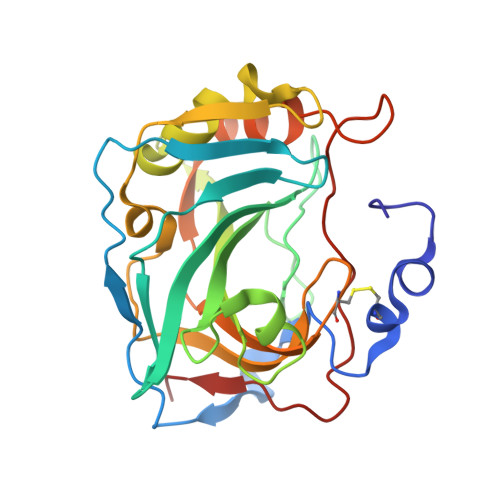Halogenated and di-substituted benzenesulfonamides as selective inhibitors of carbonic anhydrase isoforms.
Zaksauskas, A., Capkauskaite, E., Jezepcikas, L., Linkuviene, V., Paketuryte, V., Smirnov, A., Leitans, J., Kazaks, A., Dvinskis, E., Manakova, E., Grazulis, S., Tars, K., Matulis, D.(2020) Eur J Med Chem 185: 111825-111825
- PubMed: 31740053
- DOI: https://doi.org/10.1016/j.ejmech.2019.111825
- Primary Citation of Related Structures:
6QN0, 6QN2, 6QN5, 6QN6, 6QNL, 6QUT, 6R6F, 6R6J, 6R6Y, 6R71 - PubMed Abstract:
By applying an approach of a "ring with two tails", a series of novel inhibitors possessing high-affinity and significant selectivity towards selected carbonic anhydrase (CA) isoforms has been designed. The "ring" consists of 2-chloro/bromo-benzenesulfonamide, where the sulfonamide group is as an anchor coordinating the Zn(II) in the active site of CAs, and halogen atom orients the ring affecting the affinity and selectivity. First "tail" is a substituent containing carbonyl, carboxyl, hydroxyl, ether groups or hydrophilic amide linkage. The second "tail" contains aryl- or alkyl-substituents attached through a sulfanyl or sulfonyl group. Both "tails" are connected to the benzene ring and play a crucial role in selectivity. Varying the substituents, we designed compounds selective for CA VII, CA IX, CA XII, or CA XIV. Since due to binding-linked protonation reactions the binding-ready fractions of the compound and protein are much lower than one, the "intrinsic" affinities were calculated that should be used to study correlations between crystal structures and the thermodynamics of binding for rational drug design. The "intrinsic" affinities together with the intrinsic enthalpies and entropies of binding together with co-crystal structures were used demonstrate structural factors determining major contributions for compound affinity and selectivity.
Organizational Affiliation:
Department of Biothermodynamics and Drug Design, Institute of Biotechnology, Life Sciences Center, Vilnius University, Saulėtekio al. 7, Vilnius, LT, 10257, Lithuania.
















